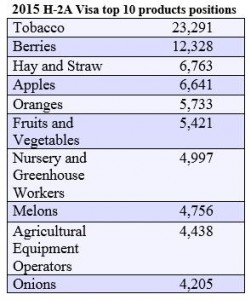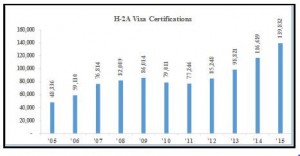Tobacco: Top User of Agriculture Guest Worker (H-2A) Visa Program
With the run up to the 2016 presidential election, we have seen a growing debate on the need for border security versus the shortage of agriculture workers. Tales of apples rotting on trees and produce left in the field are offered as evidence of jobs Americans won’t do. Yet, according to the U.S. Department of Labor’s (DOL) Office of Foreign Labor Certification program, we have a record number of guest worker visa holders. In agriculture alone, the number of H-2A visa holders has risen nearly 35% in the past decade.
Considering the increase of H-2A visa holders, how is it those who grow our food are struggling to bring in their crops? Where are all the workers? Well, according to DOL reports, a majority are harvesting tobacco, working in landscape nurseries, and operating equipment. Annual reports show the tobacco industry is consistently the largest single sector employer of agriculture guest worker visa holders. In fact, a tobacco trade organization, the North Carolina Growers Association (NCGA), touts itself as the nation’s largest user of the H-2A agricultural “guest worker” program. And, though the Center for Disease Control (CDC) reports a steady decline in U.S. smokers, the industry is experiencing a growth in acres planted and yields.
The resurgence comes after an initial dramatic decline in tobacco farming following the implementation of the Fair and Equitable Tobacco Reform Act of 2004 (FETRA). That legislation ended nearly 70 years of farm subsidies and marketing quotas. Then, beginning with the following year (2005), the feds stepped in with the Tobacco Transition Payment Program (TTPP). A program that paid nearly $9.6 billion to farmers for the lost value of their marketing quotas over a ten-year period. Also, with the low costs guest workers and the benefit of federal export assistance, the industry has gained a world of new consumers through exporting. For those health conscious consumers, tobacco now qualifies for certification under the USDA’s National Organic Program (NOP).
As well, according to a recent report by the Federal Trade Commission (FTC), in 2012, tobacco companies spent $9.6 billion marketing cigarettes and smokeless tobacco in the United States alone. An amount of about $26 million each day, or more than $1 million an hour. Not to mention federal funds at work to assist in identifying medicinal uses for tobacco.
It may appear the relationship between tobacco farming and the government makes no sense, but it actually makes an awful lot of cents. In 2014 alone, federal revenue from tobacco tax amounted to $15.56 billion dollars. Projections through 2020 show an anticipated $157.12 billion into government coffers (no pun intended). American tobacco farming is a windfall tax source for the federal government.
In summary, tens of thousands of agriculture guest workers are designated to work in tobacco while food products go unharvested. The government spends billions to burn food for fuel in its failed ethanol experiment. We have an unprecedented amount of illegal immigration due to a broken system. It goes to show, even a practical program, as is the H-2A visa, government involvement inevitably distorts the original intent.

Whoa,Whoa,Whoa. The ethanol experiment has not failed. You obviously have not looked into the industry because you used the tired ” burn food for fuel” argument. When you fully research the topic you will find that ethanol is actually a by product and does not reduce “food” production. The making of ethanol simply removes the sugars from corn, leaving behind what is called “distillers dried grain” which is used for livestock feed. It’s sort of like 2+2=5 scenario. Ethanol is also a cheap method for raising octane in gasoline.
Hello Rick,
Thank you for your comment. I would like to clarify the “animal feed by-product” argument for you and other readers. First, can we agree that the distilled remains of the corn to ethanol process is not a suitable human feed product? So, when we talk of “burn food for fuel”, the red herring argument of “livestock” feed hijacks the debate and is a distraction from the legitimate issue. Food is being removed from the market.
Second, most are unfamiliar with the basics of livestock farming and as so, it is reasonable for most to accept the deceptive claim of corn ethanol remnants being an equal source of livestock feed in comparison to corn. But, as one with a working history of livestock farming, I can assure you that is not the case.
To explain, the by-product, or dried distiller’s grain (DDG) as it is referred to in the livestock industry, is a feed “source”, this much is true. However, it is not equally comparable to, or adequate to provide for the full nutritional components as is corn. The DDGs, though a feed source, must be augmented with high-priced nutritional supplements to equal what corn provides. This is particularly important to dairy cows. Also, as the artificial, subsidized ethanol industry grew, the price of corn moved to unprecedented levels, causing human and livestock food prices to soar. This, in turn, moved all other feed products to rise in price.
As livestock farmers scramble to find alternative feeds, and auxiliary products to supplement what DDGs do not provide, it becomes difficult to maintain consistency in the animal’s total mixed rations (TMR). That directly impacts herd health, growth, progeny, and production rates. For dairy cows, daily milk volumes, as well as the fat and protein levels, are immediately impacted. Inadequate nutrition reduces conception rates and that in turn will have a negative impact on the future economic health of the operation. For chicken farmers, egg production and quality are dependent on stable, reasonably priced feeds. Add to that growth of the feeder animals. Turkeys and Pigs as well. Slower growth, poor production, higher feed costs, and lower conception rates all equate to higher use of artificial hormones. None of this good for the consumers. ALL of this negatively impacts food prices. We can see the ripple effect of the flawed policy of ethanol legislation. I could go on, but that would be a blog post of its own.
This is all basic information from my own “hands-on” working experience and knowledge. But, for those who like university studies and scientific data, there is plenty of that as well. One recent example is from the Department of Animal Sciences of the University of California at Davis, along with POET Nutrition, Inc. and printed in the Journal of Animal Psychology and Animal Nutrition. The study concluded, “These findings indicate that use of DDGS in rations for lactating dairy cows should be limited, as their addition (i.e., to create a diet with a higher fat and calculated NEL level) had little positive overall impact on animal performance.”
Although the ethanol trade groups have worked diligently to promote the narrative the by-product being a valuable feed source, it is not suitable as a supplement to corn removed from the human market and is not near equal to livestock corn.
Cheap? Nonsense. Last a I looked it costs considerably more to produce than gas, nicks everyone with subsidies, has worse mileage, worse performance and for many cars is NOT recommended but used because there is no longer any labeling at the pump. Why? No one wanted to buy it. So the labeling was removed. You want it in your car? Fine. But let me choose.